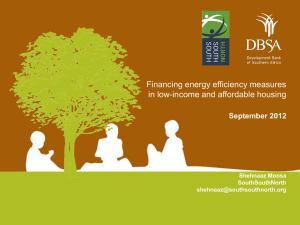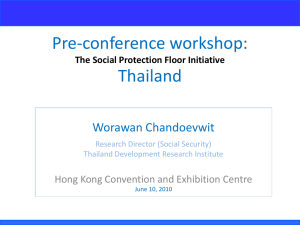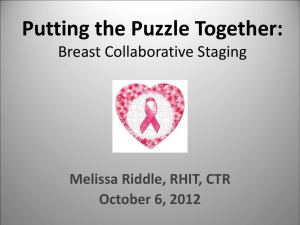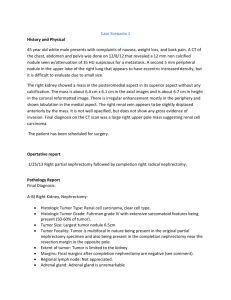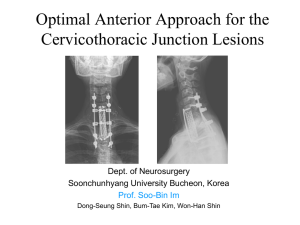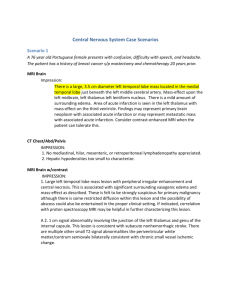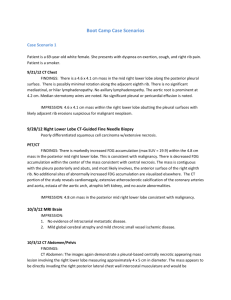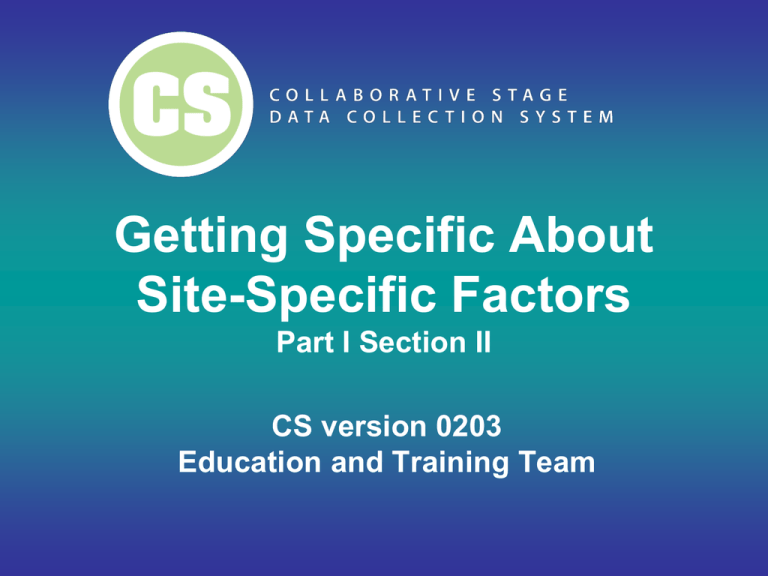
Getting Specific About
Site-Specific Factors
Part I Section II
CS version 0203
Education and Training Team
Overview
• CSv0202 to CSv0203 changes
• What are Site-Specific Factors?
• Types of Site-Specific Factors
– Examples
• Code structures
5-1-2011
CSv0203 Changes
• Based on post-publication changes in AJCC
Cancer Staging Manual, seventh edition
• Continued work to make CAP Protocols
compatible with registrar abstracting needs
• Thorough, independent review of codes and
format by Data Validation Team
5-1-2011
Coding of Lab Test Interpretation
• Priority of information
– Code clinician’s interpretation
– If no MD interpretation, registrar may interpret from
reference range listed on lab report
– If no MD interpretation and no reference range
listed, code as 999
• Use common sense and code 010 rather than 999 if lab
result is extremely abnormal
5-1-2011
What Are Site-Specific Factors?
• Part of CS data set
• Data fields with different meanings depending
on schema
• Additional information serving many purposes
• Not all site-specific factors are required
5-1-2011
Site-Specific Factors, cont’d
• SSF data sets
–
–
–
–
–
–
–
–
Breast – 24
Eyelid, lacrimal gland – 15 to 16
Testis – 13
Prostate – 12
Ocular adnexal lymphoma – 12
Head & Neck sites (carcinoma, melanoma) – 9 to 11
Colon and Rectum – 10
CNS – 8
• Standards setters determine which SSFs are
required
– www.cancerstaging.org/cstage/manuals/index.html
5-1-2011
Types of Site-Specific Factors
•
•
•
•
•
•
Needed for TNM mapping
Prognostic/predictive
Tumor markers and lab values
Future research/special interest
Associated diseases and conditions
Schema discriminators
5-1-2011
SSFs Needed for TNM Mapping
• Supplementary information
– Difficult to quantify in core data field
– May be non-anatomic
• Usually required by COC and SEER
• Examples
– Number of positive axillary nodes (breast)
– Gleason score (prostate)
– Systemic symptoms at diagnosis (lymphoma)
5-1-2011
Cutaneous Melanoma
SSF1 – Thickness/Depth of Invasion
SSF2 – Ulceration
From: Melanoma of the Skin. In: Greene, F.L., Compton, C.C., Fritz, A.G., et al., editors.
AJCC Cancer Staging Atlas. New York: Springer, 2006: 207-216. ©American Joint
Committee on Cancer.
5-1-2011
GIST – Mitotic Count
• Mitotic count: number of cells actively dividing
– <5 mitoses/high power field – low mitotic rate
– >5 mitoses/high power field – high mitotic rate
• Source: pathology report/protocol
– Pathologist instructions: scan slide for area of
greatest mitotic activity
MITOSIS
Source: www.ncbi.nlm.nih.gov/About/primer/genetics_cell.html. In the public domain.
5-1-2011
GIST – Mitotic Count
• Usually documented as mitoses per 50 high
power fields (HPF)
– Standard magnification is 40X
– Also described as ‘per 5 mm2 ’ (square millimeters)
• Site-specific factor code
– Implied decimal between 2nd and 3rd digit
– .8 mitoses/50HPF
008
– 5 mitoses/50HPF
050
5-1-2011
GIST – Mitotic Count
• Criteria for Stage Grouping
– Tumor size cut points: 2, 5, 10 cm
– Mitotic activity cut point: 5 mitoses/50 HPFs
ANATOMICAL/PROGNOSTIC STAGE GROUPS
Example: Stomach
Mitotic Rate
Stage IA
Stage IB
Stage II
Stage IIIA
IIIB
Stage IV
T1-2
T3
T4
T1-2
T3
T4
Any T
Any T
N0
M0
N0
N0
N0
N0
N0
M0
M0
M0
M0
M0
N1
M0
Any N M1
Low
Low
Low
High
High
High
Any
Any
5-1-2011
Prognostic/Predictive SSFs
• Enhance clinical relevance of TNM and cancer
registry data base
• Prognostic – helps estimate outcomes
• Predictive – helps determine whether patient
will respond to certain types of therapy
• Examples
–
–
–
–
Estrogen and progesterone receptors (breast)
HER2 (breast)
Gleason tertiary pattern (prostate)
IPI, FLIPI, IPS (lymphoma)
5-1-2011
Colon/Rectum SSF 6
Circumferential Resection Margin
• Required by COC, SEER, Canada
• Radial or mesenteric margin
– Width of surgical margin at deepest part of tumor
in area without serosa
– Distance in millimeters between leading edge of
tumor and margin of resection
– Not the same as proximal and distal margins
• Most important predictor of local recurrence in
rectum
5-1-2011
Colon/Rectum SSF 6
Circumferential Resection Margin
AJCC Cancer Staging Atlas (2006), Springer Science and Business
Media, LLC. Used with permission
5-1-2011
Colon/Rectum SSF 6
Circumferential Resection Margin
• Codes
–
–
–
–
–
–
–
000
001-009
010-980
988
990
991
991-996
– 998
– 999
Margin involved
0.1-0.9 mm
Exact size in mm
Not applicable: Information not collected
No residual tumor
Margins clear/negative, distance not stated
Nonspecific codes “< xx”, “> yy”,
“between xx and yy”
No surgery; no histologic confirmation
Unknown; CRM not mentioned
5-1-2011
Colon/Rectum SSF 9 – KRAS
• Required by COC, SEER
• Oncogene that predicts response to cetuximab
or panitumumab
– Primarily tested on Stage IV patients
• Codes
–
–
–
–
–
–
010
020
988
997
998
999
Abnormal (mutated); Positive for mutations
Normal (wild type); Negative for mutations
Not applicable: Information not collected
Test ordered, results not in chart
Test not done (not ordered and not performed)
Unknown; Not documented in patient record
5-1-2011
CNS schemas SSF1 – WHO Grade
• Required by COC, SEER
• Code
Description
010
Grade I
020
Grade II
030
Grade III
040
Grade IV
999
Clinically diagnosed/grade
unknown*; Not documented in
medical record
* Code 999 also includes tumors that are
not WHO graded.
5-1-2011
Brain/Other CNS SSF 4
Methylation of MGMT
• Required by COC, SEER
• MGMT—enzyme that repairs DNA
– Methylated MGMT repairs less DNA may
prolong survival
• Codes
– 010 Yes – Methylated; Hypermethylated; High
levels
– 020 No – Unmethylated; Low levels
– 988 Not applicable: information not collected
– 998 No histologic examination of primary site
– 999 Unknown; Not documented in patient record
5-1-2011
Head and Neck SSF7
Upper/Lower Cervical Node Levels
• Documents whether involved nodes are above
or below level of cricoid cartilage
– Lower cervical nodes have worse prognosis
Level of cricoid cartilage
Image source: CSv2 User
Documentation, Part I Section 2
5-1-2011
Head and Neck SSF7
Upper/Lower Cervical Node Levels
• Codes
000 No lymph nodes involved
010 Upper level lymph nodes involved
Levels I, II, III, VA, “Other groups”
020 Lower level lymph nodes involved
Levels IV, VB, VII
030 Upper and lower level lymph nodes involved
040 Unknown level lymph nodes involved
Code “mid neck” and levels V, VI here if not
specified as upper or lower
999 Unknown, not stated
• If not obvious, refer to list in Part I, Section 2 of
CS User Documentation
5-1-2011
Part I Section 2 Table I-2-3 Example
Lymph Nodes of the Head and Neck Showing Level
and Site-Specific Factor Positions
Name
Level
SSF7 Code
SSF3-6 Position
---
---
--
--
Note 1. Look for a statement of upper or lower cervical nodes or that the involved
nodes are above or below the lower border of the cricoid cartilage and code
appropriately. If no further information, use code 40 in SSF 4.
5-1-2011
Tumor Markers and Lab Values
• Codes actual value or interpretation of test (or
both)
• Pathologic values
– Blood tests
– Examination of tissue
• Confirm diagnosis
– AFP, HCG
• Document tumor volume
– CEA
– CA 19-9
• Prognostic
– CA-125
5-1-2011
CNS schemas SSF 2 – Ki-67 / MIB-1
• Tumor marker that indicates percentage of cells
that are actively dividing
– Separates good prognosis and poor prognosis
• Codes
–
–
–
–
–
–
–
–
001-100 1-100% (exact Labeling Index percentage)
200 Labeling Index (LI) normal
300 LI slightly elevated, no percentage provided
400 LI elevated, no percentage provided
988 Not applicable: information not collected
997 Test ordered, results not in chart
998 Test not done (not ordered and not performed)
999 Unknown or no information;
Not documented
5-1-2011
NET schemas – Chromogranin A
• Source: clinical lab report or path report
Other names
– Serum chromogranin A, CGA, chromogranin
• Marker for neuroendocrine tumors
– Specific but not sensitive immunostain for
neuroendocrine cells. Positive more often for
well-differentiated NET (carcinoid) than poorlydifferentiated NET (neuroendocrine carcinoma).
• Site-specific Factor note
– Record the highest CgA lab value recorded in the
medical record prior to treatment.
– Example: pretreatment CgA of 400 nanograms per
milliliter (ng/ml); record as 400
5-1-2011
NET schemas – Chromogranin A
Code
Description
000
0 ng/ml
001
1 or less ng/ml
002-979 002-979 ng/ml
980
980 or greater ng/ml
988
Not applicable: information not collected for this case
997
Test ordered, results not in chart
998
Test not done (test was not ordered and was not performed)
999
Unknown or no information
Not documented in patient record
5-1-2011
Heme-Retic SSF1 – JAK-2
• Other Names
– JAK2, Janus kinase 2, Exon 12
• Acquired gene mutation increases
susceptibility to several myeloproliferative
neoplasms (MPNs).
– Polycythemia vera – positive in > 90%
– Essential thrombocythemia – positive in ~ 50%
– Also primary myelofibrosis, CMML
• JAK2 does not identify which specific MPN is
present – clinical correlation needed
• Required for COC and SEER
5-1-2011
Heme-Retic SSF 1 – JAK-2
Coding Guidelines
• Code JAK-2 test as documented in a
laboratory test (whole blood or bone marrow)
or elsewhere in the medical record.
– Code for any hematopoietic disease for which
JAK-2 is tested.
– If JAK-2 not mentioned, use code 999 for a HemeRetic schema disease such as leukemia or multiple
myeloma where JAK-2 is not normally tested.
– If JAK-2 is positive but the specific mutation is not
stated, code as 850.
5-1-2011
Heme-Retic SSF1 – JAK-2
Codes
• 000 JAK-2 test result stated as negative
• 010 JAK2 test performed, positive for mutation
V617F in exon 14
• 020 JAK2 test performed, positive for mutation of
exon 12
• 800 JAK2 test performed, positive for other
specified mutation
• 810 JAK2 test performed, positive for more than
one mutation
• 850 JAK2 test performed, positive NOS; specific
mutation(s) not stated
5-1-2011
Future Research/Special Interest SSFs
• Tests infrequently performed
• Applicable in limited circumstances
• May be collected prospectively
• Examples
– CTCs and DTCs (breast)
– TILs (Merkel cell)
– Involvement of Corpus Spongiosum/Corpus
Cavernosum (penis)
5-1-2011
Microsatellite Instability
• SSF7 in colon, rectum and appendix schemas
• SSF5 in small intestine schema
• Pathologic test
– Determines likelihood of a specific gene mutation
for hereditary non-polyposis colorectal cancer
(HNPCC)/Lynch syndrome
• Codes
–
–
–
–
–
020
040
050
060
988
MSI Stable; No microsatellite instability
MSI unstable low; Positive, low – not genetic
MSI unstable high; Positive, high – genetic
MSI unstable, NOS; Positive, NOS
Not applicable: Information not collected
5-1-2011
Lung SSF 2 – Visceral Pleural
Invasion/Elastic Layer
• For tumor < 3 cm, invasion of
visceral pleura upstages T
– PL1-PL2 T2
– PL3 T3
5-1-2011
Lung SSF 2 – Visceral Pleural
Invasion/ Elastic Layer
• Required by COC, SEER
• Codes
000 No evidence of visceral pleural invasion; not
through elastic layer (PL0)
010 Beyond visceral elastic pleura, limited to
pulmonary pleura; through elastic layer (PL1)
020 To surface of pulmonary pleura; Extends to
surface of visceral pleura (PL2)
030 Extends to parietal pleura (PL3)
040 Invasion of Pleura, NOS
988 Not applicable: Information not collected
998 No histology of pleura
999 Unknown if visceral pleural invasion is
present; Not documented in patient record 5-1-2011
Associated Diseases and Conditions
• Items selected by TNM chapter authors
• Complete clinical picture of cancer
• Examples
– History of asbestos exposure (mesothelioma)
– Retinoblastoma gene mutation (retinoblastoma)
– AIDS/HIV status (lymphoma, Kaposi sarcoma)
5-1-2011
Head and Neck SSF 10
HPV Status
• Required by COC, SEER and Canada for
some H&N sites
• Human papilloma virus (HPV) infection may
be a favorable risk factor for oral and other
mucosal cancers
– Highest risk strains for cancer are types 16 and
18
• Code results from any tissue, not just
primary site
• Many codes—read carefully
5-1-2011
• Codes
–
–
–
–
000
010
020
030
– 040
–
–
–
–
–
–
050
060
070
988
997
998
– 999
Head and Neck SSF 10
HPV Status
HPV test neg; Negative, NOS; High risk neg, low risk unstated
LOW RISK pos (all pos type(s) low risk)
HIGH RISK pos, spec type(s) other than 16 or 18*
HIGH RISK pos for HPV 16 WITHOUT pos results for HPV 18
or pos of HPV 18 unknown* ^
HIGH RISK pos for HPV 18 WITHOUT pos results for HPV 16
or pos of HPV 16 unknown* ^
HIGH RISK pos for HPV 16 AND HPV 18 * ^
HIGH RISK positive, NOS, type(s) not specified
Positive, NOS, risk and type(s) not stated
Not applicable: Information not collected
Test ordered, results not in chart
Test not done (not ordered and not performed),
including no path specimen available for HPV testing
Unknown or no information; Not documented
* WITH or WITHOUT positive results for low risk type(s)
^ WITH or WITHOUT positive results for other high-risk types
5-1-2011
Brain SSF 3
Karnofsky Performance Score/Scale
• Functional status at time of diagnosis
• Code physician statement in record; do not
interpret description of status
– If information not collected, use 988.
– If no stated score, use 999.
• General categories
– 80 – 100 Able to carry on normal activity and to
work; no special care needed
– 50 – 70 Unable to work; able to live at home and
care for most personal needs; varying
amount of assistance needed
– 10 – 40 Unable to care for self; requires
equivalent of institutional or hospital
care; disease may be progressing rapidly
– 0
Dead
5-1-2011
Schema Discriminators
• Determines which schema to display for a case
• Extra information stored in SSF25
• Schema discriminators needed for
–
–
–
–
–
–
Hepatic ducts vs. cystic duct vs. common bile duct
Nasopharynx vs. pharyngeal tonsils (adenoids)
Stomach vs. esophagus-GE junction
Ciliary body vs. iris
Lacrimal gland vs. lacrimal sac
Peritoneum (sarcomas, male/female) vs. female
peritoneum (carcinomas)
5-1-2011
Stomach/Esophagus GE Junction
SSF25 – Schema Discriminator
• Necessary because of shift of C16.0, parts of
C16.1 and C16.2 to esophagus TNM staging
• Esophagogastric junction (EGJ) tumors:
– If midpoint (epicenter) within 5 cm of EGJ and also
extends into esophagus, classify and stage as
esophagus
– Stage all others with midpoint in stomach > 5 cm
from EGJ or those within 5 cm of the EGJ with no
extension into esophagus as gastric carcinoma
5-1-2011
Stomach/Esophagus GE Junction
SSF25 – Schema Discriminator
• Esophagogastric Junction
• Gastroesophageal Junction
From Edge et al. Used with permission of the American Joint Committee on Cancer (AJCC), Chicago,
Illinois. The original source for this material is the AJCC Cancer Staging Manual, seventh edition
(2009) published by Springer Science and Business Media LLC, www.springerlink.com.
5-1-2011
SSF 25: Involvement of Cardia and
Distance from GE Junction
• 000 No involvement of esophagus or EGJ
Stomach
• 010 Tumor located in Cardia or EGJ
EsophGEJ
• 020 Esoph or EGJ involved AND tumor midpoint
from EGJ ≤ 5 cm
EsophGEJ
• 030 Esoph or EGJ involved AND tumor midpoint
from EGJ > 5 cm
Stomach
• 040 Esoph or EGJ involved AND tumor midpoint
from EGJ unknown
EsophGEJ
• 050 Esoph and EGJ not involved but tumor midpoint
from EGJ is ≤ 5 cm
Stomach
• 060 Esoph involved or esoph involvement unknown
AND tumor midpoint from EGJ > 5 cm or unknown
AND MD stages case using esoph definitions
EsophGEJ
• 999 Involvement of esoph not stated, unk or no
info, not documented
Stomach
• Blank for Stomach cases C16.3-C16.9
Stomach
• Blank for Cardia/EGJ cases C16.0
EsophGEJ
5-1-2011
Melanoma Ciliary Body/Melanoma Iris
SSF25 Schema Discriminator
Code Description
010
020
100
Schema
Ciliary Body
MelanomaCiliaryBody
Includes Crystalline lens, Sclera, Uveal tract,
Intraocular, Eyeball
Iris
MelanomaIris
OBSOLETE DATA
MelanomaCiliaryBody
RETAINED V0200
C69.4 - originally coded
in CSv1
Image source: Malignant Melanoma of the Conjunctiva.
In: Edge SB, Byrd DR, Compton CC, eds. AJCC Cancer
Staging Manual. seventh ed. New York, NY: Springer,
2009 (546).
5-1-2011
SSF Codes for Lab Values
• Lab tests
000
001 – 979
980
988
997
998
999
0 result
Actual value
980 units or greater
Not applicable: Information not collected
Test ordered, results not in chart
Test not done (not ordered and not
performed)
Unknown or no information
5-1-2011
Codes for Other SSF Types
• Lab Value Interpretation
010
Positive/elevated
020
Negative/normal; within normal limits
030
Borderline; undetermined if pos or neg
988
Not applicable
997, 998, 999 Same as other SSFs
5-1-2011
Codes for Other SSF Types
• Size/depth
000
001 – 979
980
988
990
991 – 997
999
Not found
Actual measurement (cm, mm)
980 units or greater
Not applicable: Information not collected
Microscopic focus [or related terms]
Measurement ranges
less than y units, more than x units,
between x and y units
Unknown or no information
5-1-2011
Codes for Other SSF Types
• Conditions/History of disease
000
010
020-090
988
998
999
Condition not present/No hx of disease
Condition present/Hx of disease
Variations of condition present
Not applicable
No histologic examination of primary site
Unknown or no information
5-1-2011
Use of SSF 900 Series Codes
• 987
• 988
• 997
• 998
• 999
Not applicable (case does not meet
criteria for SSF)
Not applicable: information not
collected for this case
Test ordered, results not in chart
Test not ordered OR No histologic
examination of primary site
Unknown; not documented
5-1-2011
Coding Rules for Lab Test and
Tumor Marker Interpretation Fields
• Reference ranges for background only
• Code clinician’s/pathologist’s interpretation of
test. Examples:
–
–
–
–
Abnormal
– Elevated
Normal
– Equivocal
Present
– Absent
Physician statement of T, N, or M value or stage
group implied interpretation of a lab value
• If no interpretation, use reference range listed
on test report
• If no interpretation and no description of
reference range, code 999
5-1-2011
REMINDER
Site-Specific Factors
• If information regarding SSF is not in
path report or medical record, Registrar
is not required to go looking for it
– Information may not be available in some facilities
– Not registrar’s role to enforce practice standards
– Instructions included in schemas on how to code
missing information
5-1-2011
www.cancerstaging.org/cstage
• Website includes
–
–
–
–
Coding instructions (downloadable PDFs)
Implementation Guide
Standards setters requirements for SSFs
Installation program for bookmarked and
hyperlinked Part I and Part II documents
– Site-specific schema
• Natural order (online)
• Alphabetic order (online)
• Schema Groups (downloadable PDFs)
– Access to software
– Access to I&R
– Information about educational initiatives
5-1-2011
CAnswer Forum
• Submit questions to CS Forum
–
–
–
–
Located within the CAnswer Forum
Provides information for all
Allows tracking for educational purposes
Includes archives of Inquiry & Response System
• CS Forum: http://cancerbulletin.facs.org/forums/
• CS Web Site: www.cancerstaging.org/cstage
51


